

Firstly, here are the earliest photographs found showing Garton & King's shop, which was situated on the north side of Exeter's High Street at number 190, part-way between the junction with North Street and Broadgate.
Below left: This very early photograph from around 1860-1870 shows the junction of North Street and High Street, looking east down High Street. Garton & King's shop at 190 High Street is just four doors down on the left, with the Royal Crest above the first floor windows. St Peter is in his alcove (he's now in the Royal Albert Memorial Museum) on the corner above Holman & Co the Chemist who moved to this location about 1830.
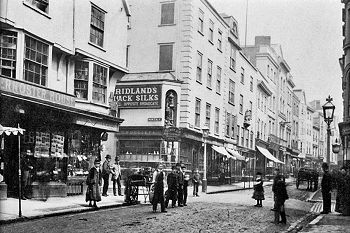 |
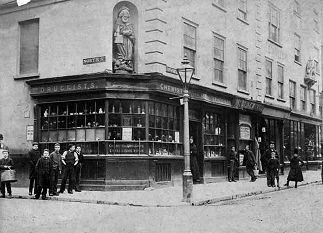 |
Above right: This next image shows the junction of North Street
and High Street in 1880, forty three years into Queen Victoria’s reign.
The cameraman seems to be the object of much curiosity to all the people in
the image!
Garton & King's shop, with the Royal Crest above, can be seen
at the extreme right. Some idea of the shop's interior layout is given later
on this page.
Below left: This image again shows quite
clearly Garton & King’s premises with the Coat of Arms above. Slightly
less interest in the photographer! The use of vertical poles to support the
shop blinds was commonplace - the brass inserts that held the bottom end of
the pole in place can still be seen in the granite kerbstones in High and Queen
Streets.
This photograph was used on a postcard in The Wrench Series of Postcards,
Number 737 entitled St Peter’s Corner. Mr Evelyn Wrench (1882 -1966) was
the initiator of this Postcard Series. For a time in the early 1900s it was
the largest Postcard Company in Britain. The actual postcard from which this
image is taken is dated August 1913 – the view dates from before 1890.
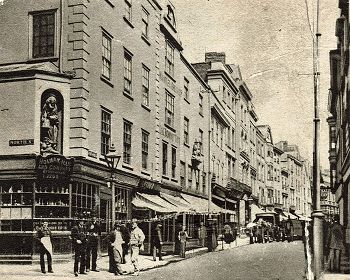 |
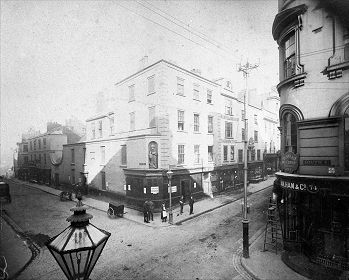
|
Above right: This image is dated about 1891 or 1892. The chemists Holman & Co. have just moved across the road; The signwriter is completing the sign on their new premises to the right. Their former premises on the North Street corner (seen empty here by the lamp post) displays posters stating ‘Removed Opposite’. That building was later replaced by the current brick-fronted building - just visible in the next photo below. Notice the telegraph pole in these two images - Exeter had its first telephone exchange in 1883.
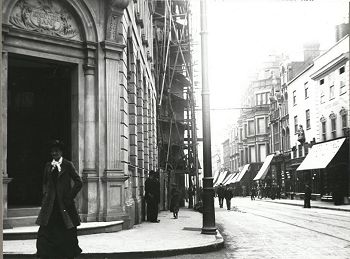 Right: Views of Garton & King’s shop at 190 High Street
are scarce, this one, taken in 1905, particularly hard to find. The purpose
of this image was to record the widening of High Street by the demolition of
buildings adjacent to St Petrock’s Church. However it also offers a sharp
image of the Shop Front opposite, still complete with the Coat of Arms.
Right: Views of Garton & King’s shop at 190 High Street
are scarce, this one, taken in 1905, particularly hard to find. The purpose
of this image was to record the widening of High Street by the demolition of
buildings adjacent to St Petrock’s Church. However it also offers a sharp
image of the Shop Front opposite, still complete with the Coat of Arms.
Eventually,
some six years after Queen Victoria’s death (22.1.1901) the newly formed
Royal Warrant Holders Association (1907) ordered Garton & King (as well
as many other holders of Queen’s Warrant throughout the land) to “Remove
immediately the Arms that are erected on the outside of the front of your premises
and kindly have this attended to at once.”
(photo by kind permission of Devon Archives &
Local Studies)
One event occurred on 9th February 1856 that
could have had devastating effects not only on the High Street premises of Garton &
Jarvis (as it was at the time) but also on the adjoining properties.
Trewman’s
Exeter Flying Post recorded, on the 14th February 1856:-
TERRIFIC GAS EXPLOSION – On Saturday evening an explosion of gas occurred in the shop of Messrs. Garton & Jarvis, ironmongers etc. of this city. There is a large gas pipe under the floor in the shop and between the ceiling of the cellar, in which there was a leak. A man and a boy went down to examine it, and having found the leak they turned off the gas from the meter in the shop, and proceeded to the cellar with a lighted candle. A quantity of gas having in the meantime escaped, the candle coming in contact with it, a terrific explosion took place. The floor of the shop was violently lifted, stoves were displaced, and forty panes of glass in the inner window and three panes of plate glass in the shop window were smashed. A man, who was walking across the shop at the time of the explosion, was struck by a plank, which had been removed from the floor, and violently ejected into the street. The man in the cellar escaped uninjured, but the boy was slightly burnt in the face. The cause of this violent explosion is attributed to a concentration of gas between the ceiling of the cellar and the floor of the shop. If the leak had been neglected for a quarter of an hour longer the consequences would probably have been that much more serious.
Fortunately the premises survived until its ultimate closure in 1933, some 77 years later. The two photos below were taken in 1933, possibly on a Sunday.
So, extinguish all cigarettes and pipes and let me set the scene for your exploration of Garton & King’s High Street Emporium before it shuts!
It’s late on a winter’s day and it’s getting dark. You’re back in the reign of Queen Victoria; you’re peering through the Shop Front of Garton & King the Ironmongers at 190 High Street in the city of Exeter.
All manner of goods are on display in the Shop windows, kitchen utensils, plated wares, wrought iron goods, paints, lacquers, cutlery & pans and trivetts - the list goes on. Its cold and wet outside and the shop looks bright, warm and inviting. You push against the polished brass door handle and immediately hear the jingle of the bell. The floor is wooden and and worn; there is a heady mix of smells, the smell of seeds, of turpentine, hessian and leather. The gas lights hiss and flicker and as you become accustomed to the light you notice that a variety of items are hung from the ceiling and goods are stacked at the end of the heavy wooden counters.
Take a step or two into the front shop and you’ll notice a central set of stairs to the upper Showroom Area and to the right a door leading to the Counting House. This is where the takings are counted; the accounts are raised and the books kept and made up. Moving further into the shop and you notice the back wall, to the left is a door signed ‘Machine Room’ - to the right of this is a door leading to an outside central passageway which takes you back into the bowels of the premises.

Pass through the door and down the alleyway.To the left a small toilet marked ‘Customers Only’ and a door to the right leads into an extensive and packed room displaying all the different models of stoves and ranges - from the massive Exonian Range to the small and compact Cottage Stove.
A pace or two more down the corridor and on the left is the doorway to ‘The Spade Room’ here are all manner of forks, spades, rakes shovels and hoes, some with and some without their wooden handles which appear to come in an assortment of lengths styles and shapes.
Beyond this door are two more doors.The one to the right leads to an area full of a large variety of goods, some wrapped and labelled, others neatly packaged or in sacks. Looking in to the room on the left of the passage are benches with large reels of brown wrapping paper and sharp blades against which you tear off the required length for wrapping the multitude of small goods. There are coils of string, lengths of sacking and there is a a distinctive sort of sisally smell as well as the odour of sealing wax.
Beyond this on the left is the Paint Store - oil paints, tar paints, enamels, bottles of methylated spitits, casks of linseed oil and a whole host of tins, drums, barrels and kegs.
The last door on the right before the substantial door that leads to Waterbeer Street is the Nail Store - not just nails - screws, brads, carriage bolts, square bolts, round bolts, nuts, rivets, chains, machine screws - the list is endless - and this is just at ground level!
On your way through the shop you may also have noticed some very old oak
wall panelling - this is a small section of it.
When the shop closed in 1933,
the panels were removed and stored. Later (1937) the panels were installed in
the new Tan Lane Foundry at the foot of the main staircase leading to the office.
At the closure of the foundry the panels were removed again and put on display
at the Royal Albert Museum, but more recently were returned to Garton King Appliances
for safe keeping.
So take a trip back in time and scan through just a fraction of the sort of goods you could see and buy back during the 1860s, 70s and 80s - enter the premises of Garton & King ...
at the Sign of the Golden Hammer
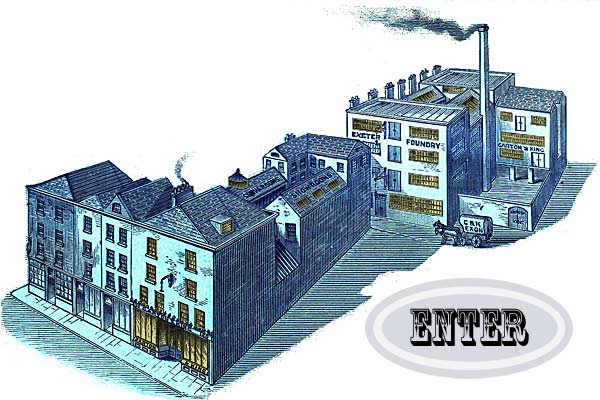
The Chevalier House, Woolworths and Garton & King
Ltd.
This next image may be familiar to those of you that enjoy
the historical photographs in Peter Thomas’s books on Exeter and its history
and the many photographs from the Isca Collection. This one relates to the Old
Chevalier Inn, one of two gabled 17th Century houses (78 & 79 Fore Street,
llustrated below right) that stood approximately on the site of the Wetherspoons
Pub today (2023). Around 1930 these two properties were threatened with demolition
by Woolworths, who, at that time were located next door at numbers 76 &
77 Fore Street, and had been there for about 5 years, who wished to expand and
build an extension in the modern style of the day. The full story is in the ‘Aspects
of Exeter’ by Peter Thomas, page 92.
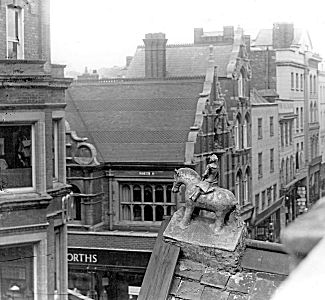 Image courtesy Nick Hake / Isca Collection |
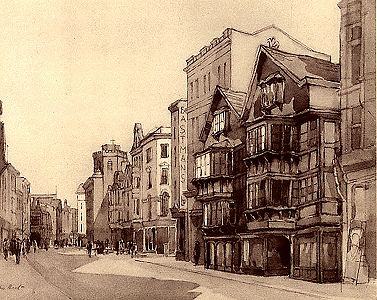 |
Fortunately the public and other institutions raised funds to purchase the property, and that you might think was the end of the story - but no, in 1942 the properties were destroyed by bombing. The rider on horseback relates to the Royalists and was placed as shown in the image on the roof to commemorate the visit of Prince Charles (later King Charles II) in 1644. The Parliamentary forces regained Exeter in 1646. However, forget for a moment the Horseman – and look beyond up High Street; the third building from the Junction with North St. is Garton & King’s Ironmongers shop (the plainer frontage shop with a row of four first-floor windows), and if you look carefully there is the large bracket from which the Golden Hammer hangs. The photograph was taken before the premises closed and I’d guess about 1930.
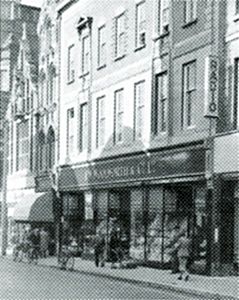 And
Woolworths? Well, as it happens, they purchased Garton & King’s Ironmongers
shop and Pinder & Tuckwell’s shop next door at 189 High Street (see
images on this page) and moved in in 1934 as shown in this last image. (Image
courtesy Nick Hake / Isca Collection)
And
Woolworths? Well, as it happens, they purchased Garton & King’s Ironmongers
shop and Pinder & Tuckwell’s shop next door at 189 High Street (see
images on this page) and moved in in 1934 as shown in this last image. (Image
courtesy Nick Hake / Isca Collection)
Updated August 2025
Top of Page
See also:
Workplace —
144 Years of Newspaper Adverts
King & Munk —
Waterbeer Street Foundry
Tan Lane Foundry —
Cooking equipment
Sitemap
/ Contents